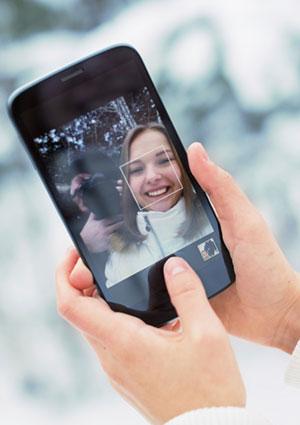
If your phone has a camera, you probably have quite a few photos stored on the phone. If you are like many people, the photos are on your phone - and nowhere else - creating a potential for those photographed memories to be lost forever if your phone is lost, stolen or breaks. Depending on the type of phone you have, though, there are plenty of options to backup mobile photos.
Use an Online Service
Uploading your images to the web is probably the simplest backup method. There are several free options that allow you to upload images via an app that you can download to your phone.
Google+
Google+ is a great no-cost online storage option because it provides 10GB of free storage, the ease of uploading and the ability to edit the photos on your phone or from your computer. You will need to have a Google account to use this option. If you do not have an account, you can set one up free.
To use Google's system, install the Google+ app on your phone and then adjust the setting to accommodate how you want your images handled when uploaded to your Google Drive. You can control image size, and whether or not to share your images publicly, as well as if you want them to be backed up automatically.
By setting up the app to automatically upload your photos, you never have to worry about your images ever being lost. If you are on a limited data plan, though, adjust the app's settings to only upload your photos via Wi-Fi only (not network and Wi-Fi) so you don't incur data charges. You may also want to deselect the full-size photo option, which is Google's default, if you are concerned about storage issues.
Flickr
If the thought of Google uploading all your images automatically is not appealing, then Flickr is a great second choice. Once you have set up an account at Flickr, download their app to your phone.
Flickr's app is similar to Google's in the sense that you can edit photos on the phone or on your computer once they have been uploaded. However, it does give you a little more control over content associated with your images. This is especially true if you email the images to your Flickr account. By emailing the images, you can associate a title, description and tags with the image. Set your account's default settings to either make the images public or private when they are automatically uploaded to Flickr.
You can automate backing up your images when you set up the app. If the app is already installed, go to settings and turn on Auto Sync. Just like with the Google app, you can set your account to default to public or private view. You can also set it to only upload via Wi-Fi.
Dropbox
Dropbox is similar in concept to Google+ except that you only get 2 GB of storage with the free plan. For additional storage, plans start at about $10 a month. One of the most significant differences with Dropbox, compared to the other two services, is it that it is private by design. The platform was created with businesses in mind, so it was initially designed to let employees access files via the web. However, it does offer the ability to upload and share photos. Photos can be uploaded via an app, or by dragging/dropping images from your computer to your online account.
With the app's Camera Upload feature, your photos automatically upload to your Dropbox account. You can make the images available publicly to other people by sharing a link to the Photo folder.
Use a Hard Drive
You can also back up your images to a hard drive. However, since this type of backup is not an automated process, if you do not set a designated time to daily, weekly or monthly transfer your images, those photos may never make it to the hard drive.
USB Port
If your phone has a small USB port, you can use that port to connect to your computer or an external hard drive. If you decide to invest in an external hard drive, expect to spend at least $60 for a 1 TB external drive. Once connected, browse to the images on your phone - usually in a folder called Photos, Images or DCIM - and drag and drop the images to your computer or external storage drive.
Bluetooth
If you use Bluetooth technology, simply sync your phone and computer and wirelessly transfer your phone's images to your computer. You can also use Bluetooth to transfer the images to another phone, if desired.
Memory Card
Some smartphones have a removable SD card. To determine if it's an option on your phone turn on the camera and click on Settings. Scroll down to Storage and view your options. If you have a memory card, typical options to select will be Device or Memory Card. Simply remove the memory card from the phone, place it in a card reader and then insert the card reader into your computer via the USB port. Once connected, drag and drop images from the memory card to your computer.
Use your phone's email capability to send your images to your home email address and then download the images to your home computer or hard drive. Just remember, though, that your phone may reduce the size of an image so it can be emailed. This may cause some quality loss, although normally the images are still large enough to maintain high quality.
Portable Media
Portable media, like CDs or a flash drive, can also be used to back up photos from your phone. Depending on how you remove the images from the phone, you may have to go through a few steps to get the images onto the media. If you have a large quantity of images - and are unable to move images directly to a flash drive - consider uploading the images to an online service and then batch download a folder(s). From there, you can burn it directly to a CD or save to a flash drive. If you use Google, you can batch download by selecting an Album.
If your phone supports USB OTG technology, connect your USB port to an external hard drive or flash drive using a USB OTG cable. Once connected, transfer the images to the external device.
Create Redundancy
Since there is really no one best way to backup mobile photos, redundancy is the key. Each system has potential weaknesses. Cloud storage can be hacked, hard drives fails, portable media gets lost or your phone could be stolen or destroyed. However, if you store images in multiple places, possibly using all three methods (online, hard drive and portable media), the odds of permanently losing your images are greatly reduced. With so many options, there is no excuse for not backing up your images.
Consider Image Retrieval
One final tip: If you take a lot of images that you want to keep, create an organized way to store them by adopting naming conventions, tagging protocols and a folder system. This will let you quickly search and locate images.







